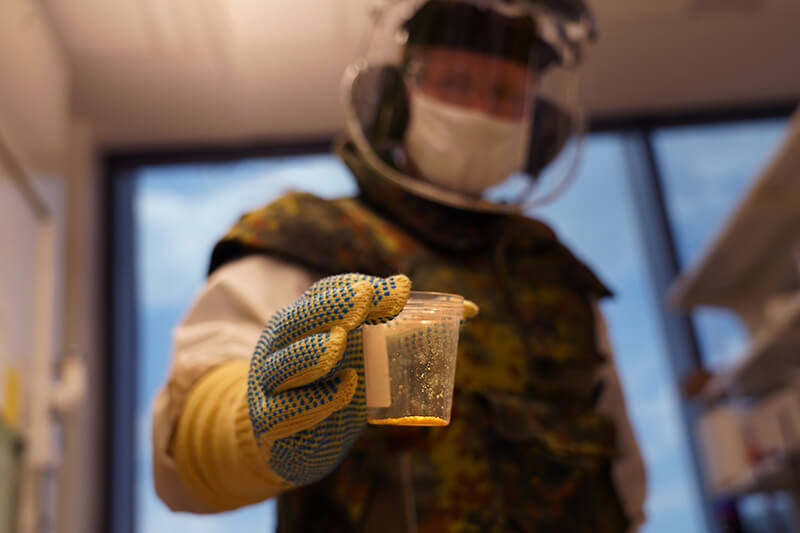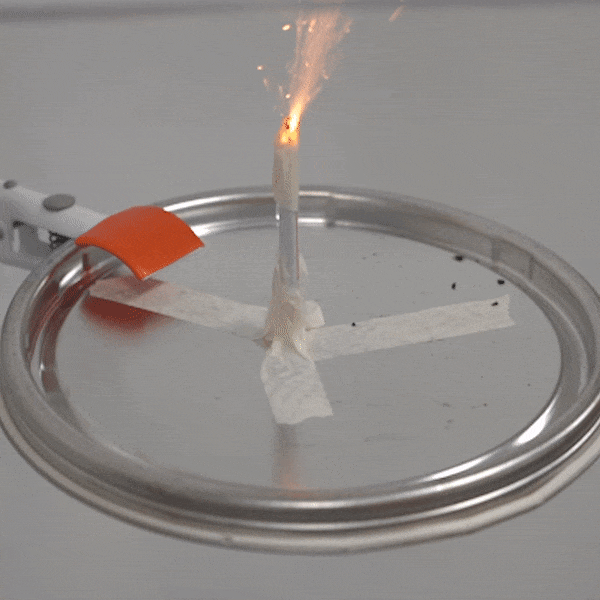August 31, 2020
Purdue, U.S. Army to collaborate on next-generation energetic materials

A just announced three-year cooperative research agreement between the U.S. Army and Purdue University’s Energetic Research Center will help the Army with its modernization efforts. (Purdue University photo/Jared Pike)
WEST LAFAYETTE, Ind. — Advancing technology associated with explosives, propellants, and pyrotechnics — what the scientific community calls energetic materials — is the goal of a new joint project between Purdue University and the United States Army.
Although the modern military makes use of many new technologies such as advanced computing, data analytics, artificial intelligence, robotics, hypersonic aviation and biotechnology, energetic materials — the things that go boom—are still the key components in many of the Army's munition systems.
Jeffrey Rhoads, director of the Ray W. Herrick Laboratories and professor of mechanical engineering, said that research related to energetic materials is important for the U.S. armed forces to achieve the modernization priorities set out in the 2018 National Defense Strategy, among other documents.
To bring the technology into the 21st century, improved scientific understanding, manufacturing techniques, safety, and sustainability are requisite. All of this needs to be done while also significantly enhancing lethality in accordance with the Army's modernization priorities.
"One of the areas of modernization is what the military calls long-range, precision fires," Rhoads said. "To ensure the long-term safety of the warfighter in the presence of emerging international threats more research in this area is needed."
Purdue's Energetic Research Center (PERC) is entering a three-year cooperative research agreement with the Army to achieve these goals. The research, which is being conducted jointly with scientists from the U.S. Army, is a comprehensive project, spanning from synthesis to manufacturing to demilitarizing ammunitions and munitions, and everything related to energetic materials in between.
 An experimental test shows the ability of silver salts to detonate just as well as commonly-used primary explosives. (Purdue University video/Jared Pike)
An experimental test shows the ability of silver salts to detonate just as well as commonly-used primary explosives. (Purdue University video/Jared Pike)
"Right now, a lot of things are still being made by hand. They're not being manufactured in a modern way, and there are many safety concerns with that. Much of this could be done using automated processes where the operator is some distance removed," Rhoads said.
Nirupam J. Trivedi, an Army scientist who serves as the U.S. Army Combat Capabilities Development Command Army Research Laboratory's chief for detonation science and modeling, said the collaboration has many goals, including workforce development and preparing future scientists in energetics materials research."
"The models, materials and methods developed at Purdue University will be transitioned to the team of scientists at our laboratory, at Aberdeen Proving Ground, Maryland, to further the development toward weapons applications to realize the goals of Army Modernization Priorities," he said.
Earlier this year PERC and the Army laboratory announced that they had jointly developed two new lead-free materials used to ignite powder inside a gun cartridge.
Stephen Beaudoin, director of PERC and professor of chemical engineering, said that the prior work is an example of the unique collaboration.
"Neither research laboratory could have made that molecule independently, but we were able to achieve it together, and that is a dramatic step forward in the field," he said.
Beaudoin said PERC has the capability to design an energetic molecule on a computer, synthesize the molecule, determine the characteristics of the molecule, formulate it into a useful compound, and determine a process that will allow it to be manufactured.
"We've built up this capability over time — our motto is 'Molecules to Munitions.'" Beaudoin said. "There is no other university in the world that can do this every step of the way, all the way through. Energetic materials are not easy to work with. They have a tremendous amount of energy stored in just a molecule. The experiments have to be very precise, and you have to be very careful. You have to have people who are highly skilled to do this type of work."
Rhoads points out that one of the ways energetic materials and munitions have changed is the current emphasis and need for sustainability.
"It's not obvious, but one of the big concerns is how environmentally friendly and sustainable these new products are," he said. "The large majority of the munitions the nation needs are never going to be used. They circulate around in the field for years and are eventually retired. A lot of these end up at a place like Naval Support Activity Crane in southern Indiana, in storage depots and have to be demilitarized."
Rhoads said there are currently 18 research projects and groups conducting energetics research as part of the project. Among the research projects:
- Gaining a better understanding of how shockwaves interact with the microstructure and defects in energetic materials.
- Improving the performance of materials used in the aggressive service conditions such as gun launch and hypersonic flight.
- Developing inkjet-printed conductive energetic materials.
- Developing new manufacturing techniques to encapsulate metal or composite materials with embedded sensors to develop health-monitoring smart armor.
"It's an interesting project. On the one hand, it's trying to increase the effectiveness of these weapons, and on the other, it's trying to increase the safety and sustainability," Rhoads said.
About the Purdue Energetics Research Center
The Purdue Energetics Research Center is the largest academic research laboratory in the world focused on energetic materials. Its research portfolio is sponsored by a large number of domestic federal agencies, including the Army Research Office, Air Force Office of Scientific Research, Office of Naval Research, Defense Threat Reduction Agency, DARPA (Defense Advanced Research Projects Agency), and a number of related Department of Defense and Department of Energy laboratories. The center comprises six core faculty members, 18 affiliated researchers, more than 120 graduate research assistants and postdoctoral scholars, and dozens of undergraduate researchers. PERC technologies have led directly to the creation of numerous small businesses in Indiana, including Adranos, Inc., Next Offset Solutions, Inc., and Level 6 Engineering, LLC.
About Purdue University
Purdue University is a top public research institution developing practical solutions to today’s toughest challenges. Ranked the No. 6 Most Innovative University in the United States by U.S. News & World Report, Purdue delivers world-changing research and out-of-this-world discovery. Committed to hands-on and online, real-world learning, Purdue offers a transformative education to all. Committed to affordability and accessibility, Purdue has frozen tuition and most fees at 2012-13 levels, enabling more students than ever to graduate debt-free. See how Purdue never stops in the persistent pursuit of the next giant leap at https://purdue.edu/.
Writer, Media contact: Steve Tally, steve@purdue.edu, @sciencewriter
Sources: Jeffrey Rhoads, jfrhoads@purdue.edu, @jfrhoads
Stephen Beaudoin, sbeaudoi@purdue.edu, @imnotoriusphd
Journalists visiting campus: Journalists should follow Protect Purdue protocols and the following guidelines:
- Campus is open, but the number of people in spaces may be limited. We will be as accommodating as possible, but you may be asked to step out or report from another location.
- To enable access, particularly to campus buildings, we recommend you contact the Purdue News Service media contact listed on the release to let them know the nature of the visit and where you will be visiting. A News Service representative can facilitate safe access and may escort you on campus.
- Correctly wear face masks inside any campus building, and correctly wear face masks outdoors when social distancing of at least six feet is not possible.
Note to journalists: B-roll and gifs of the research is available in a Google drive.

